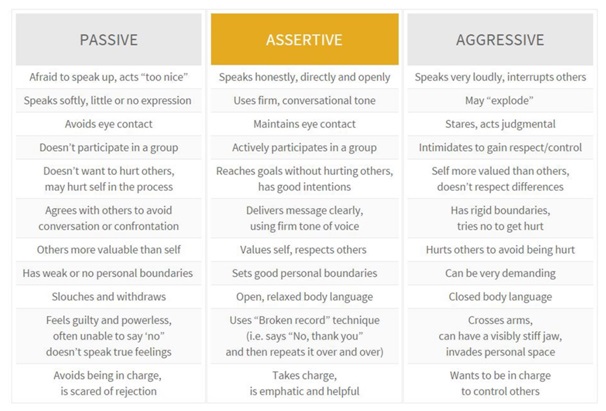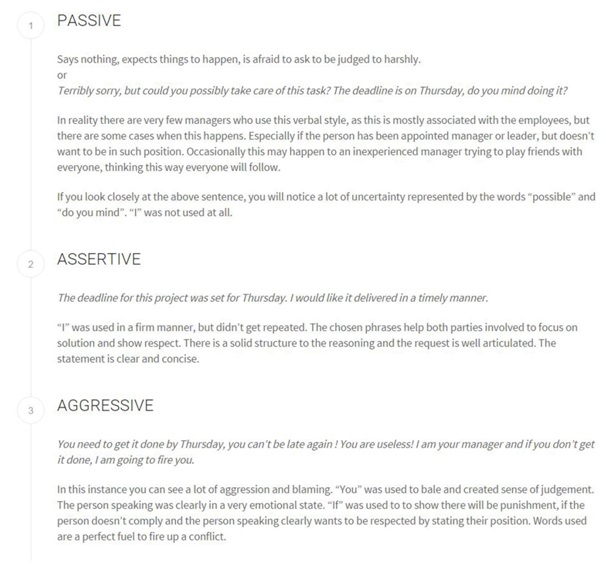
A Coaching Power Tool Created by Axela Rinoa
(Leadership and Entrepreneurship Coach, UNITED KINGDOM)
Being assertive is important to say the least and a lot of people, organisations and relationships can be built if the right approaches are involved. One of the big change makers is assertiveness in people who can speak up their minds without interrupting someone, raising their voices or working towards developing guilt in others.
Assertiveness is sometimes misunderstood by certain individuals; it can also be confused with aggressiveness. It is quite a common occurrence nowadays that we want to push higher and higher, but what price is being paid? Which path do you choose to get what you want? Are you passive, aggressive or assertive? Let’s look at the differences.
Raise your words, not your voice. It is rain that grows flowers, not thunder. – Rumi
One of the most common preconceptions assumes that the ability to say NO equals being assertive. Being assertive means much more than that; it is being aware of your own values and being able to set personal limits. It is knowing your life mission, expectations from the world and goals. It’s expressing your thoughts without hurting others. The next important aspect is being able to communicate clearly and directly without the need to interrupt someone or speak over. Language and words or phrases being used during conversations or speeches make for another part of being assertive and are a demonstration of our personality. Next is being open to different opinions and respecting them, not trying to bring the different person down just for the sake of feeling in control. An assertive person has good intentions, believes that world is a good place with space for everyone
Passive, Aggressive or Assertive?
You may have a certain idea of which one you are, but look closer, think of a few situations you have recently been in. How did you react, what were the temptations? Did you feel you had to be tough or to hide? Or maybe you felt that everyone has the right to have their own opinion. Did you want to control the group or were you open to listen to various arguments? Below is a table representing typical behaviours of the three types: passive, aggressive and assertive.
 Knowing these behaviours will not only help you become more assertive, but also, especially if you want to be a good leader, help you identify what people you are dealing with. In effect, it will be much easier to help them to achieve goals, be it personal or organisational. It will help you to move forward with your own career, personal mission and make a communication smoother. Let’s look at some sample situations illustrating the type of language which is characteristic for each of the types.
Knowing these behaviours will not only help you become more assertive, but also, especially if you want to be a good leader, help you identify what people you are dealing with. In effect, it will be much easier to help them to achieve goals, be it personal or organisational. It will help you to move forward with your own career, personal mission and make a communication smoother. Let’s look at some sample situations illustrating the type of language which is characteristic for each of the types.
Language Matters
Words, sentences, structures of your requests, speeches are an important aspect of how you will be perceived. You may have the clearest intentions, but if you can’t formulate your thoughts clearly, the effect may be further from desired that you can imagine. Below are two sample scenarios, one that could happen in a workplace and one which could happen in personal life. At the end of this post you will find a three step process that will help you communicate more assertively.
Sample Scenarios
Scenario 1
Let’s start from the office environment. Imagine situation in which a manager wants a task done by certain deadline. There are few ways he/she can ask an employee to do it.
Here’s how it could look like:
Scenario 2
Now imagine a divorced parent calling a child. He/she is frustrated that they don’t meet as often as with the other parent and would like more interaction.
Reflection: 3 Easy Steps to Assertive Communication
Be Direct – State your point very clearly, with a confident body language, firm tone of voice. Don’t let others change your emotional state and get fired up. When necessary ask questions to understand the point of view of the other party. Use “I” statements, but not too often.
Be Brief– Less is more, so avoid stacking information. Don’t confuse the other person by additional details and don’t exaggerate. Provide information related to the request and stop there. If the person will need more, they will come back with questions.
Provide Reasons – Use only facts, leave opinions and emotions on the side, think of the initial goal. Provide only information related to your request. Well-reasoned request will be taken naturally and followed with appropriate action. Avoid justifying yourself or situations.
Have in mind that being assertive means being prepared for various scenarios.
Sometimes you may need to be insistent, resistant or compromise, other times you may need to be conciliatory. Being assertive also means that you will be able to ask for help, tell someone that you don’t know everything and you may need to get back to them and many more situations. It is very important to observe others, as this will help you to choose the language and phrases appropriate to the state of the other person.
Learning assertiveness may be a lengthy process, but it is worth the effort. As with many things in life, you get better with practice. You may observe that with time it will be easier to reach your goals, ask for a pay raise, get a promotion. Expressing your feelings, thoughts freely with no fear involved is extremely helpful in building families, organisations and other types of relationships. While learning you will be challenged, involved in debates, but once you become assertive you can lead by example and teach others. You will also become much more respected and you will respect yourself. Decision making process will become easier and you won’t be hurting others in the process.
Coaching Application
Exploration of situation the clients found them in, observation of a language used to describe these can help a coach to distinguish which type of communication is being used.
The coach can then help the client gain awareness on the unintended consequences of the language and wording being used. Playing various scenarios can be very beneficial to change a perspective and show various advantages. Using an element of fun and game in adults may bring more positive outlook and relax the often tense initial attitude.
The coach needs to be curious and non-judgemental, pay a close attention to the tone of voice while speaking.
Sample Questions
- What language, phrases do you currently use?
- How do your conversations end?
- How do you feel after each conversation?
- What assumptions or beliefs are you holding that are important to your conversation style?
- How is your attitude or language serving you?
- What may be some different forms of expressing your thought?
- What words could you use to express yourself freely?

